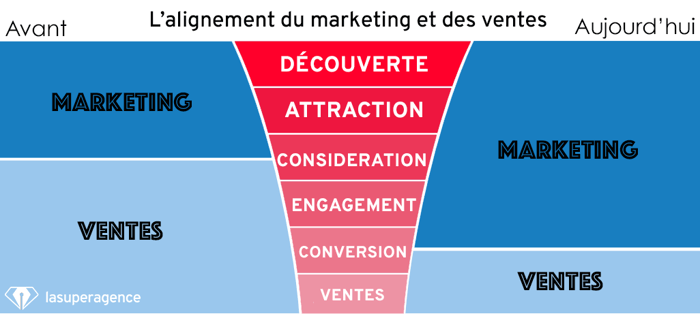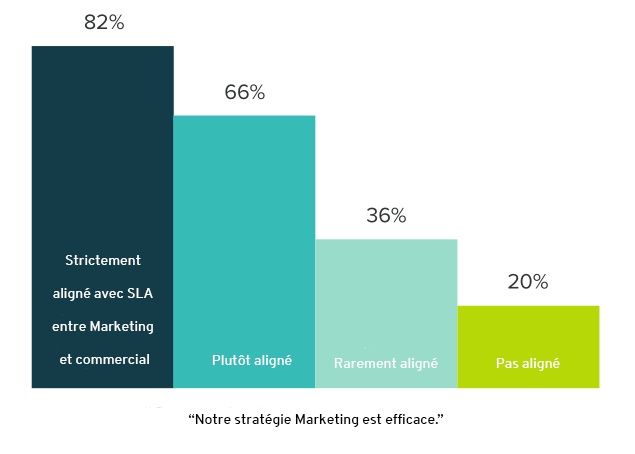Good news : the eternal conflict between Marketing and Sales can be overcome !
With the Inbound Marketing, you implement communication and feedback processes between departments to enable:
- A better profitability of actions
- An alignment of the marketing and sales teams on common goals.
In the distant past, salespeople used to push customers to buy things they didn't necessarily need.
How can you imagine, for example, that a product as outlandish as this sparsely decorated stone could sell millions of copies?
However, that's what happened in the 1970s with decorative Pet Rock which had runaway success thanks to a compelling, direct sales technique. 
Thankfully, times have changed.
Now, during the buying process, salespeople no longer control the flow of information, the customer has the power.
If customers have a question about a product or service, they Google the answer and find it instantly, individually and through a multitude of sources.
Based on this observation (among others), the Inbound Marketing emerged.
With this approach, Marketing teams play an equal or greater role than sales teams in acquiring new leads.
They therefore have an increasing influence on the sales process and revenue generation.
This is what is meant by aligning sales and marketing teams : they work together to improve the lead acquisition process (lead generation, lead nurturing, lead qualification, and making the sale).
The diagram below describes this new reality:

With Inbound Marketing, the qualification work is done in depth by the Digital Marketing teams.
How can Marketing help the salesperson make sales ?
In an Inbound Marketing approach, the stages of the lead's journey through your conversion tunnel are:
1 - The discovery or awareness stage: the potential lead realizes that they have a problem and is interested in learning more.
2 - The attraction stage: he conducts an Internet search using keywords. The work done in SEO leads him to your site.
3 - The consideration stage: the visitor feels that your service offering can provide a solution to their problem.
4 - The engagement stage: after consulting several pieces of information, he feels that you are able to help him.
5 - The conversion stage: the visitor becomes a lead by leaving their contact information to be contacted again.
6 - The sales stage: the sales department will then be able to approach the prospect with a better understanding of his specific requirements to close the sale.
We can see that the preparatory work done by Inbound Marketing allows the salesperson to optimize his relationship with his future client.
In the traditional approach, the salesperson is forced to take the lead very early, with the risk of not fully understanding his needs.
Either they will take time out of their day to qualify their contact themselves, or they will employ "aggressive" sales techniques...

Directly approaching a prospect in the discovery phase to talk about a product in your catalog could be perceived poorly.
Directing them to blogs or downloadable white papers, with the goal of better informing them, would be far more relevant in the digital age.
In an " aligned " organization, it's Marketing's job to help salespeople better understand:
1 - the qualified contacts they get back,
2 - the information that will be most critical to satisfying them.
This is where using a lead qualification tool (like Hubspot) can be effective.
It can inform sales teams where each lead is in the customer journey or how qualified it is.
A visitor can be qualified as a lead searching:
- general information
- information about different solutions
- information about the company's offerings in particular.
This is the type of information that salespeople are fond of because it allows them to know which lead is ripe to begin the sales process and which one still needs information.
MQL? SQL? What is it?
We can more specifically categorize these leads as Marketing Qualified Lead (MQL) or Sales Qualified Lead (SQL).
A MQL (Marketing Qualified Lead) or in French a Qualified Prospect for Marketing is a visitor to your website who identifies himself through a contact form (to download a white paper for example). We know their identity but we don't know their intentions.
A SQL (Sales Qualified Lead) or Sales Qualified Prospect is a lead that will have been deemed mature enough to be passed on to sales. The various interactions made by the person with your site (regular consultation of the blog, opening of newsletters, etc.) will determine the right time for the salesperson to make contact.
To use a soccer metaphor, the MQL would be the ball of the player who makes a decisive pass and the SQL would be the ball of the player who goes to score !
We can see clearly, with these fine definitions of leads, what is at stake in a good cooperation between Marketing and the sales department.
How can sales help marketing generate better leads ?
In an " aligned " organization, to reach the sales goal faster, the exchanges must be two-way.
The marketer has an advantage here: good sales most often equals good processes.
The arrival of the Internet and the online search revolution in the early 1990s allowed marketers to develop their business in the same mode, allowing for new quality measurement and evaluation criteria.

Example :
The Marketing team transfers two qualified, purchase-ready leads (SQL) to the sales team.
One requested an online demonstration and the other requested a free consultation.
The one who requested the demo did not follow through, while the one who requested a free consultation placed an order.
The sales team noticed that this happened often and informed the Marketing team: they should improve their message upfront and provide clearer explanations on the Demo Request Landing Page.
Sales teams therefore have interest in feeding this type of information back to Marketing to get better quality leads.
Integrate technology to measure and improve processes
Editors like SalesForce (CRM for customer management) and Hubspot (COS for content management) offer effective solutions to enable Marketing and Sales departments to work hand in hand.
The great strength of these systems lies in the automation of actions.
This is probably the most effective tool for measuring ROI (return on investment). Indeed, thismechanism can be constantly tested and improved until it reaches an optimized operation, generating maximum qualified leads.
Beware though: your Inbound Marketing automation platform is only as good as the information you provide it with !
For example, if the sales team receives insufficiently qualified leads, the Marketing team will need to improve its upstream qualification process.
Marketing automation is only really decisive when it allows action decisions to be made based on their ROI. This one is built in particular from the feedback of the sales teams on the actions of Marketing.
The importance of SLA
For this, it is essential to set up an SLA (Service Level Agreement) between the two functions.
This is a formal commitment, signed by both teams, to set common goals for revenue development.
Here are two key metrics that may be included in this type of "contract":
SLA from Marketing to Sales: Number of leads needed to reach sales targets.
SLA from Sales to Marketing: Responsiveness (measured time) of lead follow-up and frequency of escalations in the CRM.
The latest "State of Inbound 2016" report highlights a key piece of information: 82% of companies with "an effective Marketing strategy" have established an SLA to align their Marketing and Sales functions.

There is therefore a direct relationship between operational performance and the existence of an SLA between the two entities.
In conclusion
- Inbound Marketing helps generate higher quality leads for salespeople.
- In an Inbound Marketing approach and using the right tools, salespeople are able to bring up information that is conducive to improved targeting.
- This type of cooperation is mutually beneficial and encourages teams to become more aligned.
- The implementation of an SLA between Marketing and Sales seals this alignment and ensures better operational efficiency.








